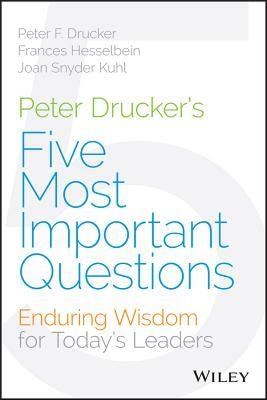
“Peter Drucker’s Five Most Important Questions – Enduring Wisdom for Today’s Leaders” by Peter F. Drucker, Frances Hesselbein and Joan Snyder Kuhl (John Wiley &Sons, $20).
Planning and continuous improvement fit hand in glove. Together they comprise “the process of strengthening what works and abandoning what does not … and making ongoing adjustments as conditions change.”
Whether you own a small business, run a nonprofit or are the CEO of a Fortune 500 company, the answers to the five questions provide an insightful self-assessment of your business model’s fluid dynamics.
▶ “What is our mission?” Succinctly identify why you do what you do. The mission remains fixed while strategy, tactics, processes, etc., respond to market realities. It’s the cornerstone that guides decision-making and the yardstick that measures results.
▶ “Who is our customer?” Don’t think of the end user as your only customer. There are also supporting customers – employees, suppliers, funding sources, etc. — on whom you rely to create products/services for end users. Both types of customers have “needs, wants and aspirations that continuously evolve over time.”
▶ “What does the customer value?” Don’t answer this question until you talk with your end user and supporting customers. The answer involves aligning what you offer with what they value. When talking to customers, you must “dig, frame and reframe” to delve into the why behind their answers.
▶ “What are our results?” Quantitative results provide data; while important, they don’t tell the whole story. Qualitative results provide individualized instances of impact. Use both to measure how well you stayed on mission and added value to end user and supporting customers.
▶ “What is our plan?” Build upon the strengths that drive the mission; abandon those that don’t. Take risk; it’s the only way to “look for tomorrow’s success.” Never really be satisfied with results; the finish line becomes the new starting line.
Key takeaway: As you answer the five questions, remember that charting the path to the future isn’t “my way.” It should involve spirited discussions with decision-makers to ensure that they have done their homework and buy in.
“Widgets: The 12 New Rules for Managing Your Employees As if They’re Real People” by Rodd Wagner (McGraw-Hill, $32).
Employees are human resources (i.e. intellectual capital), not assets (i.e. widgets) or expenses. Investing in ways that make them more valuable improves the bottom line. Managers’ heads will nod in agreement with the previous sentences, yet Wagner’s research shows that those nodding heads don’t act that way. Across the global board, employee responses to the 100-question how-am-I-treated survey averaged between neutral and agree. Nineteen percent of the U.S. employees surveyed answered neutral or lower. Clearly there’s a disconnect.
Wagner offers 12 rules that will help your human resources thrive. Of these, “Getting inside their heads” heads the list. Businesses, especially large ones, “are adept at categorization rather than individualization.” Categorizing them like interchangeable widgets overlooks the fact that motivation, learning, abilities and goals are uniquely individual. There’s no one-size-fits-all.
To get the most out of their human resources, managers must connect with them as individuals. That doesn’t mean becoming their friend or confidant. It does mean taking the time to find out what makes them tick. How? Regular “what-do-you-need-from-me” conversations help the manager identify employee-specific drivers. The other 11 rules provide the framework for addressing those drivers. When employees believe they’re heard and aren’t part of the herd, there’s positive response.
Advice before reading the book: At WidgetsTheBook.com, take the five-minute “New Rules” self-assessment developed from Wagner’s research. The results help frame your perspective of employees as human resources.
Jim Pawlak is a nationally syndicated reviewer of business books.